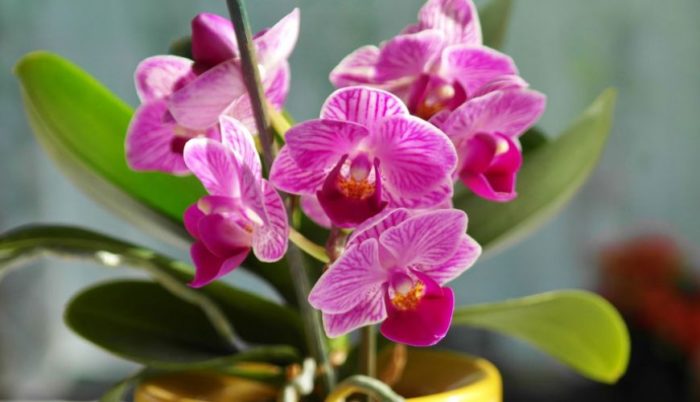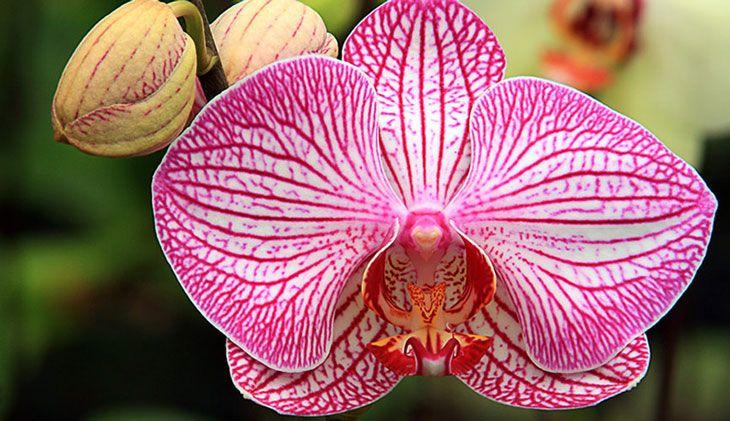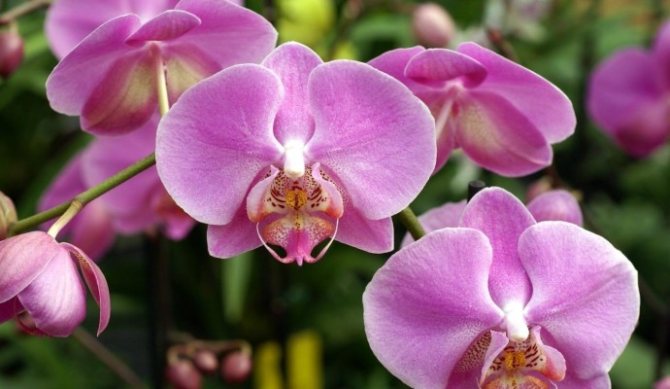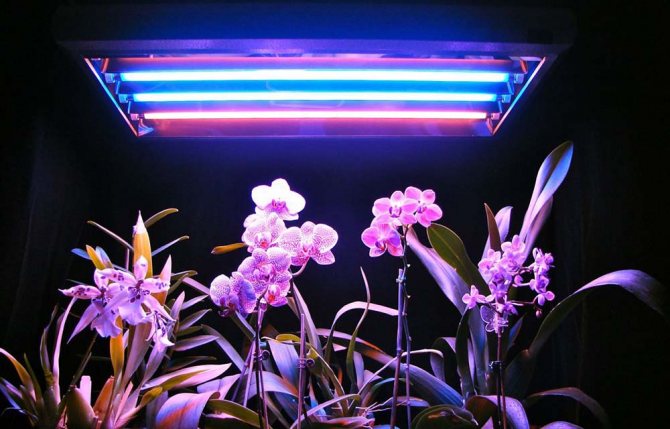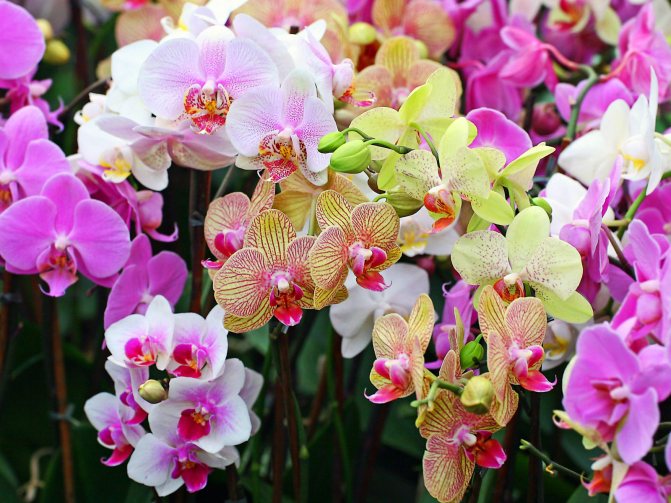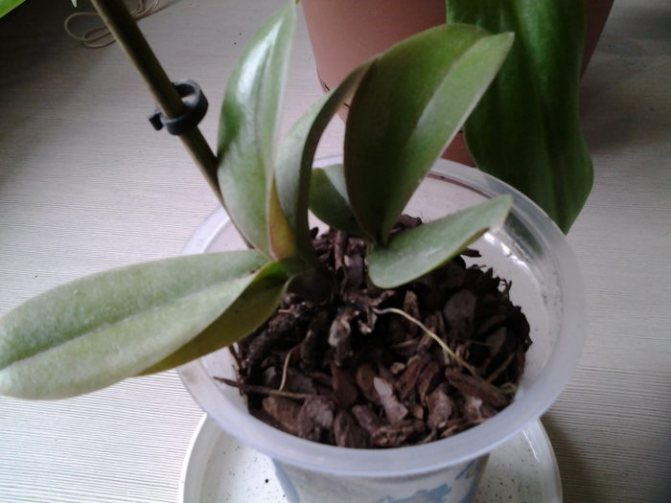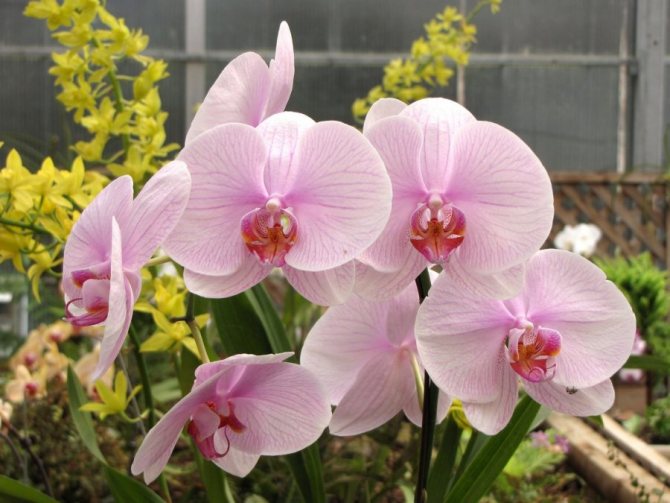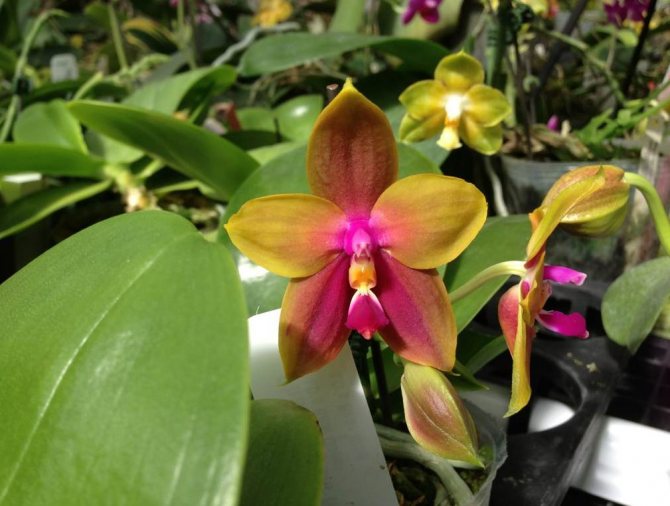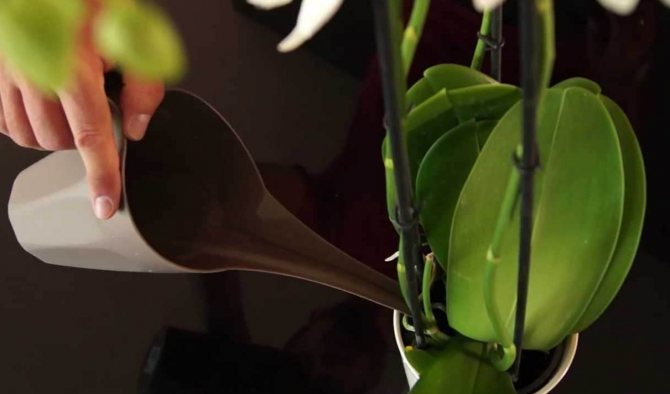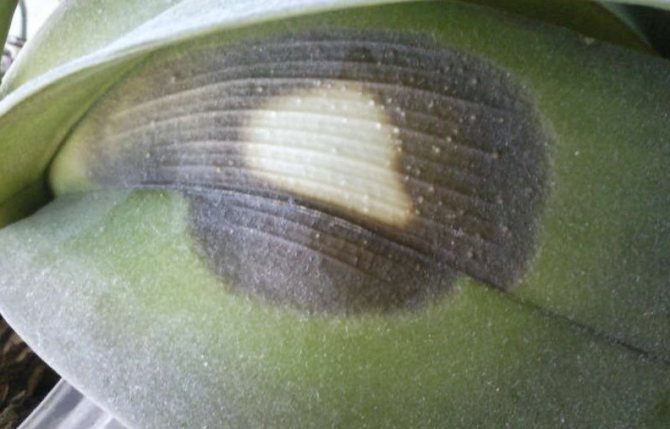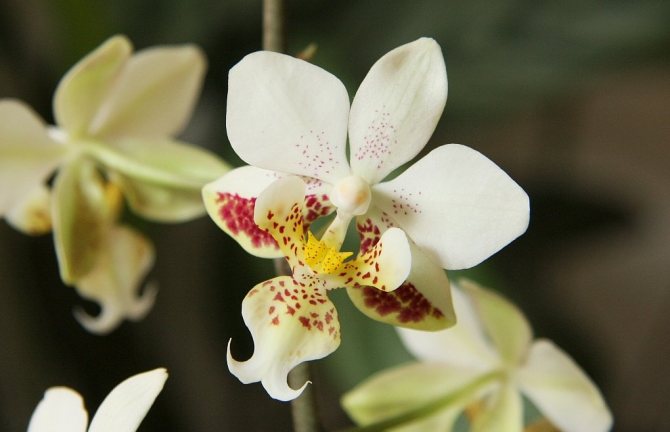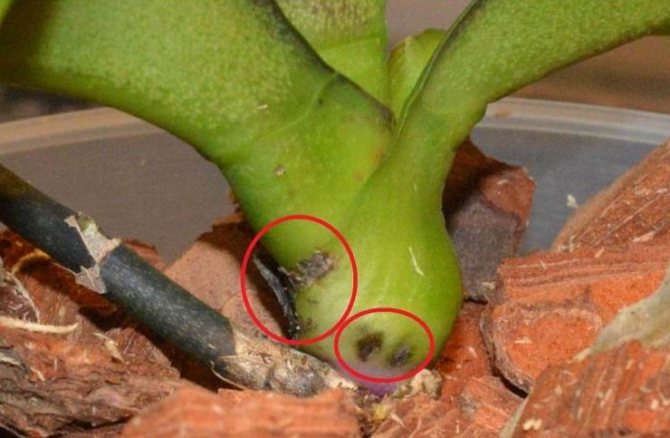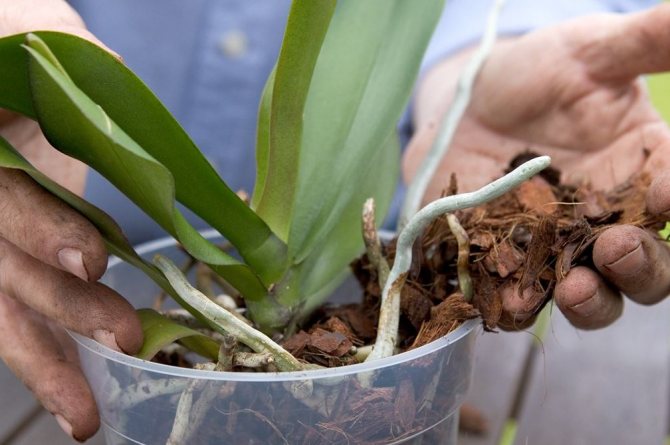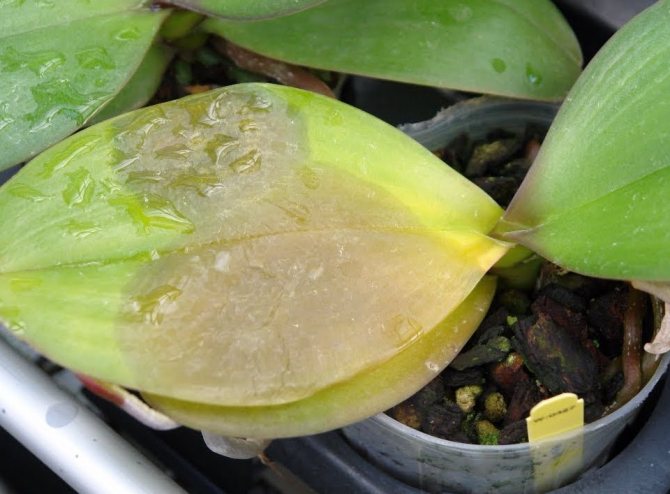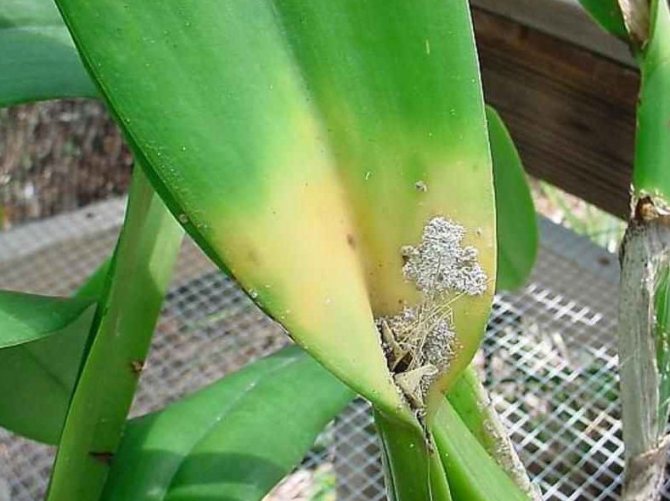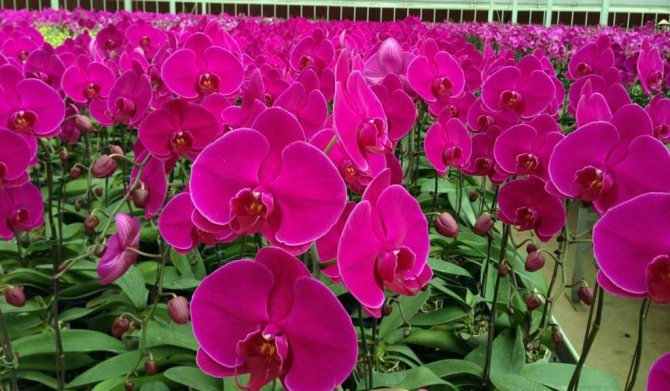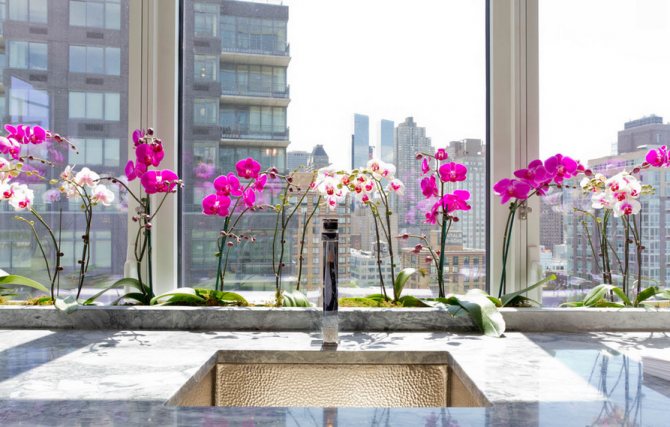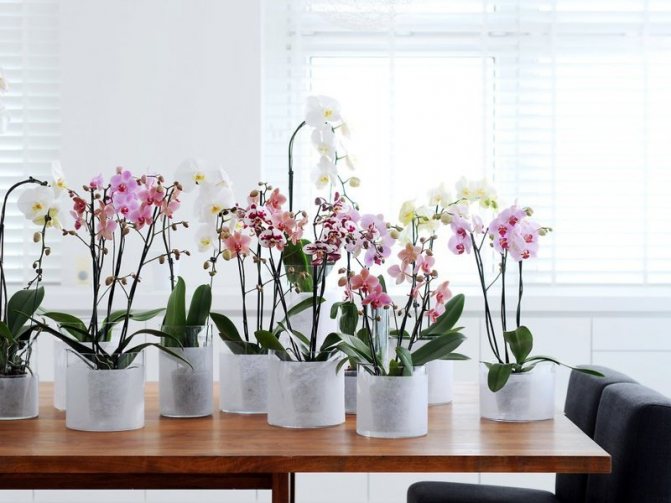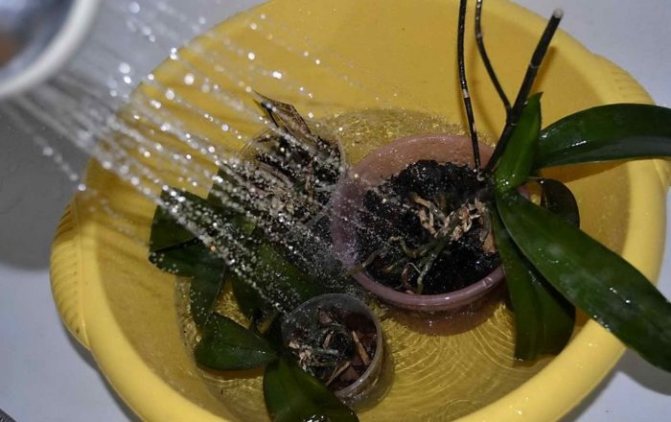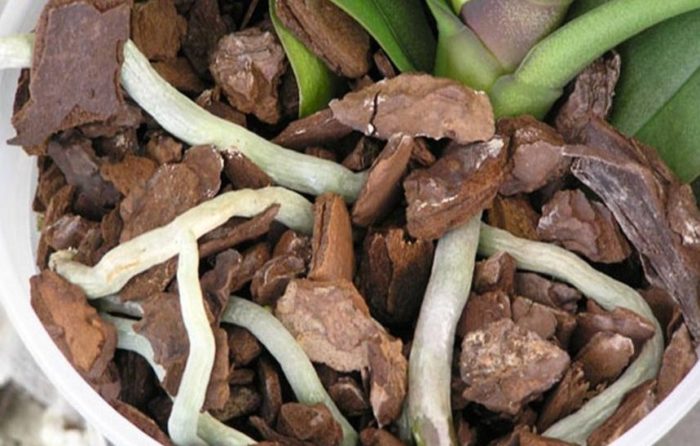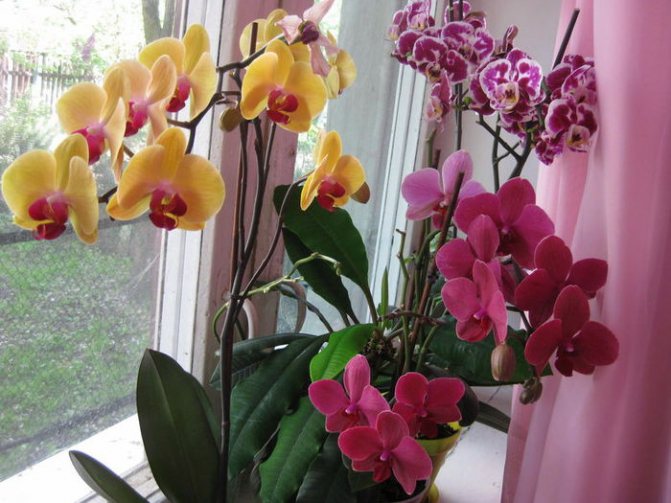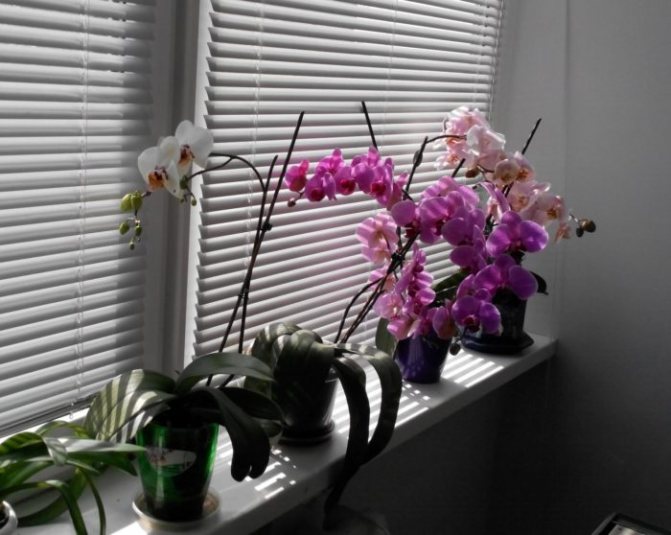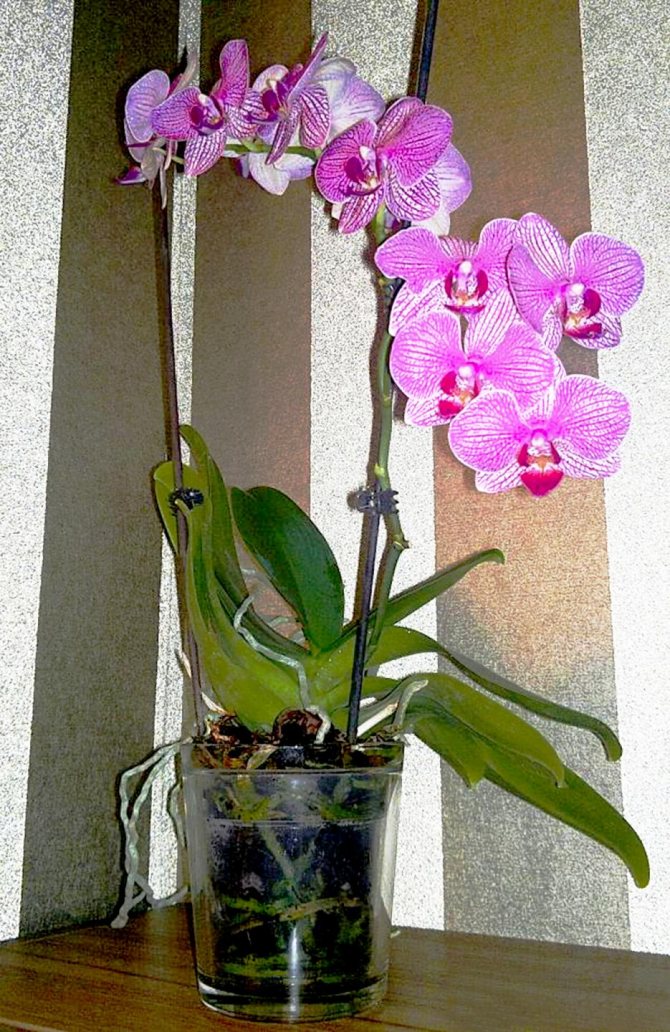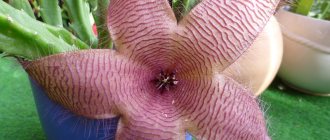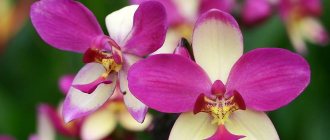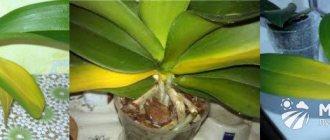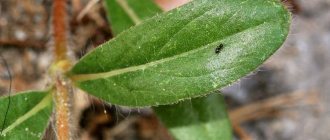Orchid is one of the most long-flowering indoor plants... By purchasing it in a store, we expect that flowers will decorate our home almost continuously.
But quite often you have to deal with the fact that this is a tropical the plant stops blooming.
You can solve the problem only by carefully studying the care recommendations and working on your own mistakes.
The orchid does not bloom, what to do to bloom. Reasons for absence
After flowering, Phalaenopsis, like other indoor flowers, has a dormant period. During this time, the stem restores the expended forces, recruits new ones.
This is followed by a period of active growth, when the flower can drive out a couple of young leaves and a new peduncle.
If the orchid does not bloom for a long time at home, it is worth considering the reasons for this phenomenon.
The period for which the peduncle should appear is different for each variety, in some phalaenopsis it is shown along with the leaf, and some drive it out after the full development of the leaf plate.
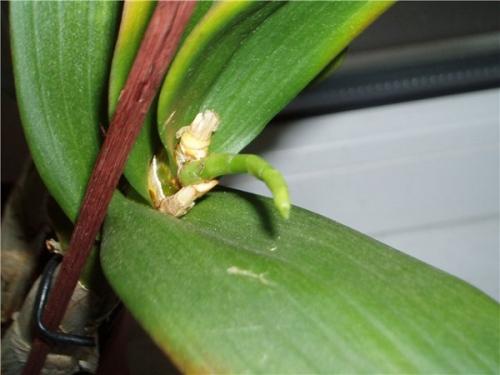
Young peduncle of Phalaenopsis.
Usually, the reason why an exotic beauty does not bloom is:
- the transferred stress state, in which even damage to the plant is possible. Stress for an orchid means a sudden change in the environment, usually when moving or when transporting the stem from the store home during the cold season. In this case, it is possible to get frostbite or simply hypothermia of the plant;
- diseases will get in the way of flowering if roots or leaves are affected. The plant simply does not receive the necessary nutrients and will not be able to drive out a high-quality peduncle. Shtambu simply won't have enough strength;
- poor care will also not accompany variegated flowers, only normal watering with a sufficient amount of fertilizer. A place without drafts, bright, but without direct sunlight, will contribute to the displacement of the peduncle by the stem and the further development of flowers on it.
In addition, in the absence of flowering, the wrong neighborhood of plants can be guilty, which should be strictly observed.
Advice! You should not grow banana trees and tomatoes on the same windowsill or near phalaenopsis. In the summer, protect the bole from the close proximity of apple and walnut trees.
How to stimulate by adjusting the length of daylight hours?
Advice: The reason for the reluctance of the orchid to bloom may lie in the lack of light. It is necessary to ensure that the plant is illuminated for at least 10-12 hours a day. To ensure this condition, a phytolamp of a suitable spectrum that does not dry air is quite suitable.
Despite the light-loving orchids, you should not put them on the southern windows in the summer.: there they can get sunburn and temperature burn. In addition, any plant needs a phase of night dormancy for the correct implementation of the photosynthesis process, so do not forget the plant under the included phytolamp at night.
The orchid does not bloom for 2 years, what to do. Analysis of the conditions for keeping an orchid
When buying a flower, you need to ask a specialist for an explanation of which variety and features of its cultivation. Phalaenopsis Orchid, the most unpretentious variety that perfectly tolerates light shading.But there are orchids for which a southern window is suitable, and even the summer heat is well tolerated by them. The orchid does not bloom if the conditions of detention are violated.
You should always put a saucer of boiled water next to the orchid. Put a clove of garlic in the substrate.
If the flower was purchased in a store, and it has already bloomed, and the arrow has turned yellow, then the rest period can last up to a year. If the plant is grown from children, then it will take more than two years to wait for the first flowering. By this time, the root system will gain strength and the orchid will release 5-6 leaves. Early flowering will weaken the beauty.
Why doesn't the orchid bloom at home after transplanting? When to wait for the first arrow? The transplanted plant first builds up its root mass within six months. After aerial roots develop, leaves grow. Flower buds are laid in the axils. The initial period of development of the plant in favorable conditions contributes to the establishment of a larger number of peduncles.
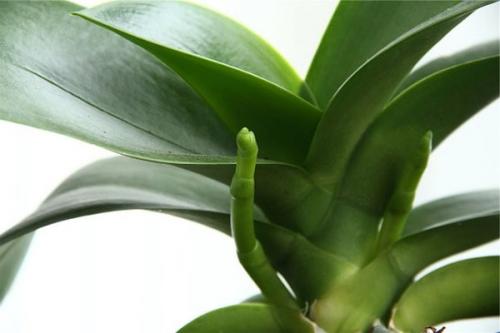

Let us remind you how to properly maintain an orchid:
- The roots are well developed, green, some of them are located along the walls of a transparent pot, some at the top, absorbing moisture from the air.
- The substrate does not contain fresh bark, sawdust or manure.
- It is better to keep the lighting diffused.
- The difference in day and night temperatures when laying the peduncles should be at least 5 degrees.
- Top dressing with liquid fertilizers, depleted in nitrogen every 10 days before the release of the arrow.
The conditions for setting flower buds are listed, but biological requirements for keeping orchids should be observed.
What if the orchid does not bloom and is developing well? You will need to provoke the release of the arrow. The aerial root and arrow look the same at first. But the tip of the arrow is rounded, and at the root it is sharp, as in the photo.
How to get the buds to give by changing the watering?
The watering regime is especially important for the successful flowering of an orchid.... How to speed up flowering by changing watering? Water the plant by completely immersing the pot in water. In order for the dry substrate to be qualitatively saturated with moisture, it is necessary to remove the flowerpot from the decorative pots and lower it into water for 3-5 minutes. After watering, the plant should be pulled out, let the excess water drain from the pot and put it in its original place.
Such manipulations need to be done every two weeks in winter and every 10 days in summer. More frequent bathing can lead to decay of the root system and disease, and sometimes the complete death of the plant.
Orchids gravitate towards the humid climate of the subtropics, so it is important to maintain high indoor humidity.where they are grown. The plant should be sprayed daily using well-settled warm and soft water.
Phalaenopsis orchid does not bloom, what to do. How and when does the phalaenopsis orchid bloom?
So, first you need to understand one botanical feature of the development of our tropical guest. When the phalaenopsis orchid blooms - the answer to this question hides in itself accompanying answers to all possible questions of inexperienced gardeners as to why the orchid does not bloom for a long time. So, the Phalaenopsis orchid blooms for the first time not earlier than 2 years after its planting. Therefore, if a flower is planted with the help of a child, then you should wait for the formation of at least 6 full-fledged leaves and then sound the alarm.
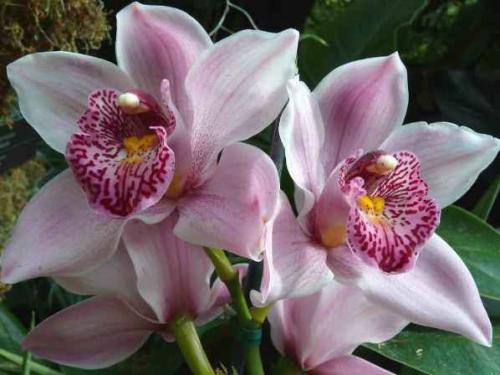

Immediately after planting, the plant begins to build up its root mass. This can take at least 6 months, depending on the planting conditions. And only after this does the development of aerial roots and deciduous mass begin. This is a very important time, since flower buds of future peduncles are laid in the axils of new leaves. Therefore, as soon as the tops of new leaves begin to appear, active fertilizing with mineral complexes should be started. But be careful.It is best to exclude nitrogen from the composition of dressings or buy such formulations where it is contained in the smallest ratio. Phosphorus, potassium and magnesium are needed to lay future flower stalks.


Another important point that concerns the question of when orchids bloom. This tropical plant has no concept of the changing seasons. In principle, it does not know about the fact that we have winter in our latitudes and the time comes to shed the foliage and stop flowering. The phalaenopsis orchid is not particularly sensitive to the length of daylight hours, since under natural conditions it grows under the cover of dense foliage of the tropical forest. Therefore, the phalaenopsis orchid is capable of blooming without interruption for up to 10 - 11 months. The time when she throws out a peduncle depends entirely on the skill and experience of the grower.
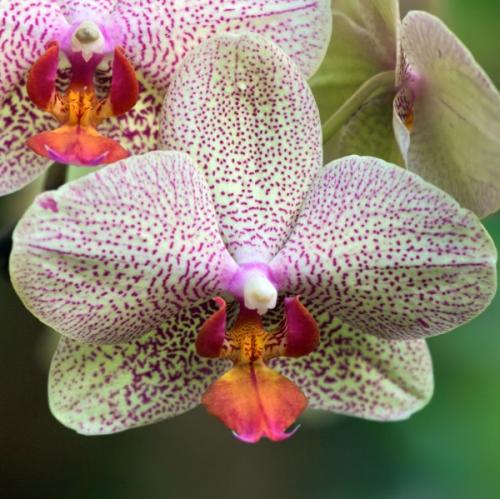

Assessment of readiness for flowering
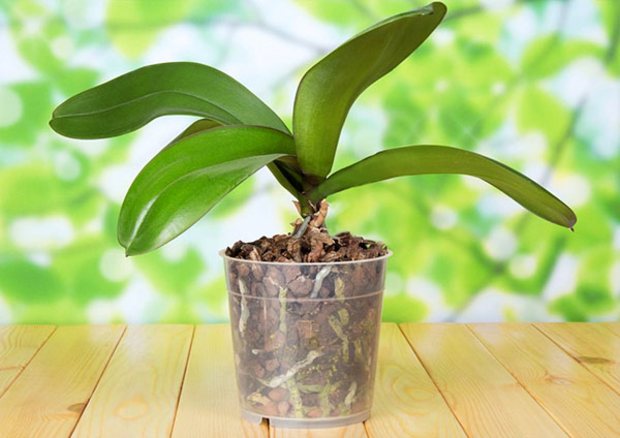

Don't wait for the orchid to bloom all year round. Also, there is no need to associate the flowering of a tropical plant with the season, since in tropical forests in the homeland of the epiphyte there is no clear separation between them. To get an orchid to release a flower stalk, you need to organize it a suitable microclimate.
You can understand whether an orchid is ready to form buds after evaluating the type of plant. To begin with, examine the root system, the leaves of the flower. The condition of the roots is especially important. After all, they reflect the health of the orchid plant as a whole. It is not necessary to remove the flower from the pot to see them. Usually, epiphytes are grown in transparent containers through which the roots are clearly visible.
In a healthy orchid, the roots are dense, yellowish or white. After watering, they turn light green. The age of the roots is determined by the peculiarities of the shade. Young and actively growing are painted in a bright tone. Older roots have a muted green color. Darkened roots in the pot indicate a problem. They are waterlogged or rotted.
Additionally, the condition of the aboveground part is assessed. Healthy leaves are firm and fleshy, with a shiny green skin. They have no wrinkles or dry ends. Growing young leaves from the outlet indicate that the flower has passed into the growing season. In a healthy plant, a flower arrow appears several times a year and forms buds ready to open.
The first formation of flowers in hybrid orchids begins after the flower reaches the age of 1.5-3 years. At the time of the formation of the first flower arrow, the orchid should have more than 5 new leaves. In some cases, the formation of the arrow occurs earlier. But such a flower stem usually dries up, since the epiphyte lacks the strength to fully bloom.
What if the orchid does not bloom, what to do. Why don't orchids bloom?
Many amateur flower growers do not understand why their orchid has not bloomed for a year, 2 years. Let's take a closer look at the main question: why orchids do not bloom and what to do at home when a problem arises?
Care errors
The duration and frequency of flowering of an orchid depends both on the conditions of detention and on belonging to a particular species or variety.
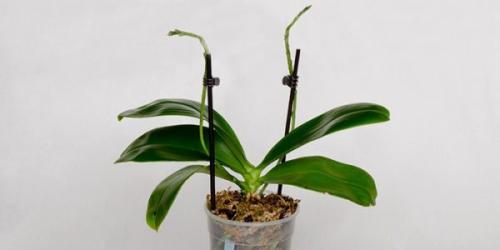

With improper care, the orchid does not bloom.
For hybrid varieties adapted to growing at home, flowering cycles up to 2-3 times a year with rest breaks. Violation of this rhythm indicates mistakes made when caring for the plant, as a result, non-flowering orchids are obtained.
Temperature violations
The homeland of orchids is humid and warm tropical forests, therefore, with room maintenance, it is necessary to observe the correct temperature regime:
- At temperatures above 25-30 ℃, plants intensively grow green mass and bloom poorly; in winter, the temperature should not fall below 16 ℃. The optimum temperature for an orchid is 20-24 ℃;
- The formation of peduncles is well influenced by the daily fluctuation of day and night temperatures in the range of 5-7 ℃.
This corresponds to the plant's natural life cycle, which triggers a safe flowering mechanism.
Lighting nuances


One of the main factors that affects the development and flowering of an orchid is light. The wrong lighting is stressful:
- Leaves stretch out, their color becomes lighter;
- Growth slows down and flowering stops;
- Peduncle does not form;
- Direct sunlight in summer causes leaf burns.
The plant is sensitive even to nuances of lighting such as unrolling the pot or moving it to another location, which can cause the flowers to shed.
Irrigation technique
Novice flower growers sometimes get too carried away with watering, as a result of which the orchid has problems:
- Frequent watering stimulates the development of vegetative parts: roots and leaves;
- Excessive moisture can cause the roots to rot, as a result of which they acquire a dark color. Such a plant will not bloom.
The watering regime must be corrected, and if rotten roots are found, the plant is transplanted into a new soil.
Incorrect feed composition
An improperly selected composition of fertilizers can be a factor due to which the orchid does not form a peduncle, for example, a variety such as cymbidium:
- Excess nitrogen stimulates the growth of the root system and leaves;
- Phosphorus in the composition of fertilizers stimulates the formation of a peduncle.
Important ! For feeding, it is necessary to use only special fertilizers for orchids with a low nitrogen content.


Make sure you have the correct fertilizer before feeding your orchids.
Above you can see a photo of how fertilizers for orchids look at home from Bona Forte. The optimal ratio of nitrogen, potassium and phosphorus to stimulate flowering is 2: 6: 6.
After transplant
The roots of the plant are very sensitive to transplanting and after it they recover for a long time. The lack of flowering during this period may be due to the fact that:
- During the first half of the year after transplanting, the root mass is actively growing. Then aerial roots are formed and leaves grow, in the axils of which flower buds are laid;
- If too many roots had to be removed during transplanting, the flower may not adhere well to the substrate, which will make it difficult to bloom;
- Improper plant maintenance and growing conditions are particularly affected.
The comfortable conditions created after the orchid transplant determine good growth, development and early flowering.
Violation of the root system


If the plant is transplanted incorrectly, the root system may be disturbed:
- Root decay due to improperly selected substrate;
- The volume of the pot is too tight for the root system;
- Injury to the roots during transplantation due to their ingrowth into the walls of the pot.
If the transplant went well and does not bloom, improper orchid care may be a possible cause.
The soil does not hold the plant
If the orchid is poorly fixed in the soil for a long time, this can affect its ability to form a peduncle. In this case, the plant must be transplanted into a suitable substrate or filled with soil into a pot.
Healthy
Sometimes an outwardly healthy plant has problems with flowering: either the orchid does not bloom, or it fades quickly.
Fats and does not release a peduncle
The reasons for not blooming can be different:
- Monotonous watering of the plant has a positive effect on the growth of leaves;
- Nitrogen predominates in top dressing, while the orchid quickly increases its leaf mass.
Adjusting the watering regime and nutrition will help restore flowering.
Only gives babies
Most likely, the temperature regime is not observed: during the day + 22-24 degrees, at night + 16-18 degrees. It is also possible that there is an excess of nitrogen in the top dressing.
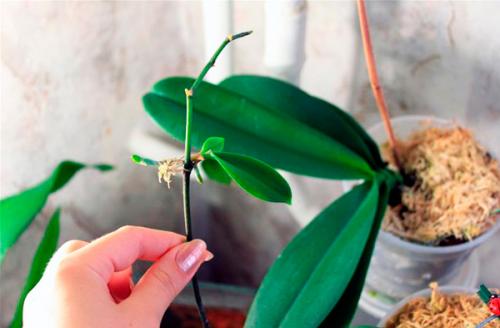

With poor feeding, the orchid does not bloom, but gives only children.
Has released an arrow, but does not bloom
The orchid shot an arrow, but the flower does not bloom for a long time. This is often due to uncomfortable growing conditions:
- If a peduncle appeared in the dark season without additional illumination, the plant will not have the strength for normal flowering;
- Low air humidity or close proximity of heating devices causes the flower-bearing arrow to dry out.
With proper care and adherence to the recommendations, the orchid will feel great at home and delight with lush flowering.
Influence of diseases and pests on the development of peduncles
A plant affected by a fungal disease or insects (aphids, soft mites, scale insects, etc.) has stopped blooming, what should I do in this case?
Attention! The main cause of orchid disease is weak immunity - a consequence of improper maintenance and care.
Treatment consists of using fungicides or insecticides. After the recovery period, the plant will bloom again.
Drops flowers and buds
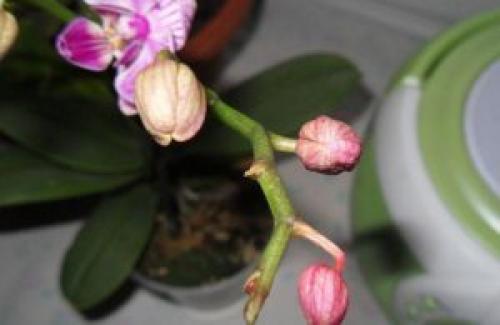

The reasons why an orchid drops flowers and buds include:
- Old substrate that has already decayed and rotted;
- Relocation to another location during flowering;
- A nearby air conditioner or a cold draft;
- During flowering, the air temperature rose above 30 ℃;
- The flowering plant is not fertilized;
- You can spray only the leaves, not the flowers.
With proper care, the orchid will delight with flowering for many years.
Why doesn't it start for a long time?
There may be several reasons why the orchid is in no hurry to please its owner with flowers for more than a year, or even two.
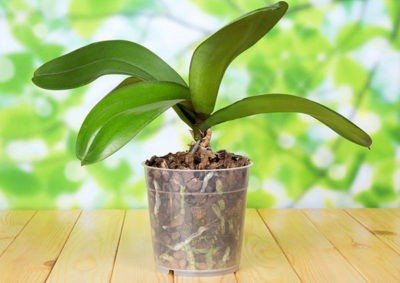

Any species of orchid plants really do not like movement in space. Even the pot turned the other side to the light source becomes a serious stress for them. As a result of the rotation and rearrangement of the plant from place to place, delays in the appearance of the peduncle may occur, as well as the falling off of already set buds may begin.- A common reason an orchid does not bloom may be due to insufficient illumination of its root system. It is the roots that provide full-fledged photosynthesis of the entire plant, so flowering orchids should only be planted in transparent pots.
- An orchid will never bloom if there is not enough light for it. Therefore, for the flowering of this plant, it is important to provide it with the proper level of illumination. On winter days, LED lamps will come to the rescue, which will help to extend the daylight hours for the required amount of time (as a rule, orchids require 10 hours of bright light for regular flowering).
- The lack of daily and seasonal temperature changes in the room also leads to a delay in orchid flowering. In this case, all that is needed for flowering is to create the plant as close to natural conditions as possible, making sure that the air temperature at night is 4-6 ° C lower than during the day. An excellent solution would be to create artificial wintering for a green pet for at least 20 days at a temperature of 5-10 ° C above zero.
The orchid has released a peduncle, but does not bloom. Step-by-step instructions on how to care if there is no flowering
Option number 1: Consider how to care for an orchid if it does not produce a peduncle, and leaves and roots do not grow.
When there is no growth and flowering of an orchid, then the reason may be in the systematic and frequent watering, the absence of differences between day and night temperatures. To solve this problem you need:
- Place the pot on a windowsill with bright lighting but no direct light.
- Water the flower every 10 - 12 days after thoroughly drying the soil.
- Arrange for orchids with a difference between night and day temperatures of 5 - 7 degrees.
Option number 2: When the orchid only grows roots, but the buds do not appear.
If there is no leaf growth and orchid flowering at the same time, then the reason is regular frequent watering, the same day and night temperatures. To solve the problem, the following recommendations have to be followed:
- Place the pot on a windowsill where there is bright light, but there are no direct rays.
- Watering is done every 10 - 12 days.
- Dry the soil thoroughly between watering.
- You also need to ensure that the orchid has a difference between night and day temperatures of 6-8 degrees.
Option number 3: If the orchid produces only leaves, but not flower stalks.
Active vegetative growth of leaves and the absence of flowering indicates an excess of nitrogen fertilizers in the soil. To solve the problem, it is important to spend a dry season for the flower.
- Allow 4 days between watering to dry the roots.
- They stop spraying, feeding until the peduncle appears.
- Organize proper lighting, supplement with cold light bulbs in winter. Keep them at a distance of 40 cm from the top of the head.


Artificially create a lack of moisture and ensure the temperature is around 30 degrees. Flower buds will appear in 1 - 2 months.
If the "drought" is carried out correctly, the peduncle will begin to grow actively, and the lower leaves will become softer.
Option number 4: The orchid has released a peduncle, but still does not bloom.
If the orchid has released a peduncle, but only leaves and roots grow, and still does not bloom, do not panic. This is an individual feature of many varieties, when the plant picks up buds, but does not dissolve them until 3 months.
Do I need to artificially stimulate the plant?
For in order for a newly transplanted orchid to produce large and bright flowers, care should be taken to artificially stimulate its flowering... It is important to make sure that the plant is completely healthy, has strong roots and strong and fleshy leaves.
- Most often, the flowering of an orchid is stimulated by placing it in a stressful situation. If the plant has begun to "lazy" and has not produced a peduncle for a long time, you can try to push it to bloom by watering. To do this, immerse the pot in water heated to 40-45 ° C and leave it there for 30 minutes.
- A hot shower is also a useful stimulant for orchid bloom. Place the plant in a bathtub and spill its leaves and roots with a very warm stream of water (the temperature must be tolerable on the hands, otherwise you can burn the roots and leaves!).
- If the orchid has never bloomed, despite the appropriate age, as well as the quantity and quality of the shoots, you can try sending it to a cool balcony for a week or two (the room temperature should not drop below 0 ° C). This procedure simulates the wintering of a plant in natural conditions, thereby bringing its flowering period closer. After you bring the flower back into the house, a peduncle will soon appear on it.
The orchid does not shoot an arrow. Why doesn't the plant release the arrow?
Important. The reasons due to which there are problems with the peduncle depend on what type of orchid we are talking about. Without knowing the peculiarities of caring for a particular orchid variety, one cannot hope for its systematic, abundant flowering!
All orchids are divided into sympoidal and monopoidal. The latter have only one point of growth, the bush does not divide, it does not have a dormant period: Wandas, Phalaenopsis, Ascocenda. Sympoids, on the other hand, need a period of rest, which should be properly ensured. In other words, what is good for phalaenopsis and dendrobium will not be relevant for wanda, cymbidium, cattleya.
Before expecting a stalk from an orchid, you need to familiarize yourself with the specialized literature on the creation of the necessary conditions for keeping a certain type of flower. And then it is necessary to analyze: why the orchid does not give a peduncle, whether the created conditions suit it, and if they are not suitable, then what should be done? If the epiphyte does not have enough light, the irrigation scheme is not adjusted, the correct temperature regime is not observed, the plant has been fed for a long time, then flowering is out of the question.
Some florists use special preparations such as cytokinin paste. It is a phytoharmonic, its main purpose is to awaken dormant buds, form shoots in the intended place, and accelerate the flowering of a plant.Another drug is succinic acid (4 tablets per 1 liter of water). A pot of orchid is placed in a solution of acid with water overnight. In order for the orchid to sprout a peduncle, it is not enough to do this once - a similar procedure should be carried out at least once a week.
Questions From Readers
At what age does the plant begin to bloom? Risks when using stimulants in young orchids
Usually, hybrid varieties, depending on the conditions of detention, begin to bloom at the age of 1.5 to 3 years. A mature plant, ready to bloom, should have at least 5-8 leaves.
At a young age, the orchid not worth holding events to stimulate growth or use chemical biostimulants. The flowering of such a fragile plant will weaken it and lead to premature wilting of flowers.
What you need to remember about the dormant period of the plant?
Dormant period, into which the plant enters after flowering, is a normal physiological state. It usually lasts several months.
At this time, flower buds are laid and an increase is formed. In this period provide:
- Reducing watering of the plant;
- Top dressing with fertilizers that stimulate the growth of green mass;
- Warm and fairly light conditions of detention.
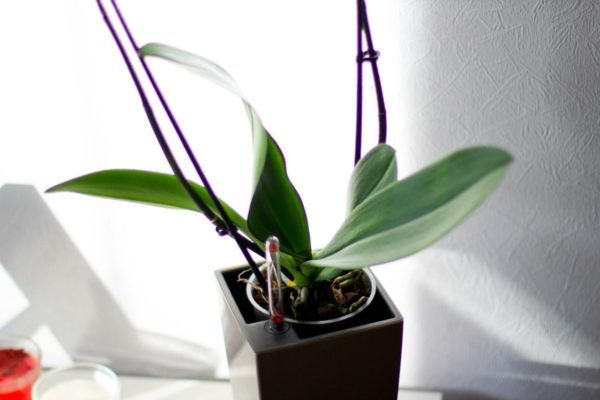

During the rest period, it is necessary to take good care of the orchid.
Upon completion of this process the plant is ready to bloomwhich occurs when the humidity, temperature and light conditions satisfy the biological requirements of a particular species.
How does the absence of stressful conditions affect the formation of a flowering arrow?
Under favorable growing conditions and good care, even without creating artificial stress, the orchid will release a peduncle.
If for some reason this does not happen, create conditions of little stress, which activates peduncle formation.
Types of indoor orchids
Having dealt with the types of orchids, it is worth noting that not all varieties can be cultivated at home. Hybrid species bred as a result of crossing will feel great.
Indoor orchids are divided into two groups:
Monopodial. These include, for example, the phalaenopsis. This group is characterized by the presence of an apical kidney. Leaves grow from it in opposite rows, so the shoot has unlimited length. The distance between the rows of leaves is different, as it depends on the type of plant. The peculiarity of the leaves is that they preserve water reserves. Their peduncles are long. It should be borne in mind that after flowering, it is not necessary to remove, and if cut off, new ones appear.


Sympodial. The peculiarity is in the inflorescences, which can be of two types: apical and lateral. In the first version, the apical bud dies off after reaching a certain size or is reborn into a peduncle, and a new one is formed at its base. In another case, lateral buds appear from the buds at the base of the shoot.
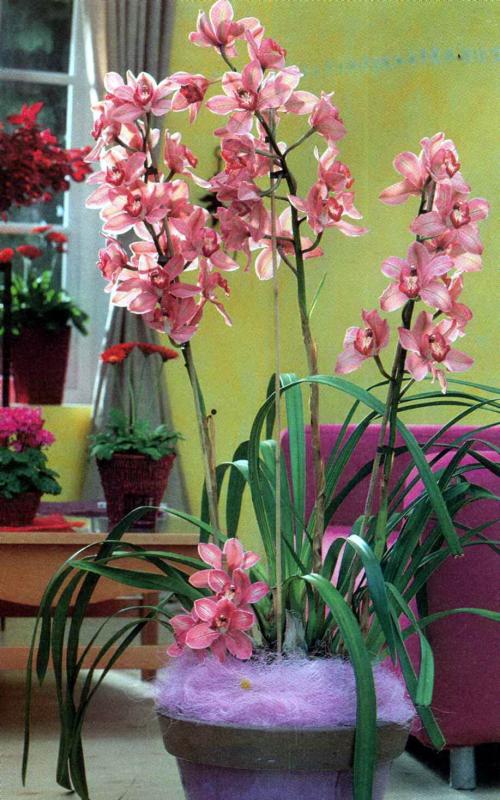

The stems are characterized by a strong thickening, later they turn into tubers of various shapes. They contain water and nutrients. The most famous species are dendrobium, cymbidium.
Errors when watering the plant
Every florist should know how to water an orchid to keep it healthy. The root system of these flowers is quite unusual and not familiar to us. Epiphytic plants do not grow in our zone, with the exception of mosses.
But in the tropical jungle, this is a common phenomenon. So beautiful orchids are epiphytic plants. This means they do not grow on the ground. The place of their growth is trees and rocky rocks.
This easily explains why their root system is so unusual. After all, the roots of orchids feed in the literal sense of the word "out of thin air." From it, they absorb the required amount of moisture and nutrients evaporated with it.
It is possible to achieve flowering of an orchid only by strictly observing all the recommendations for watering. And first of all, it is moderation. It may seem strange, but it is precisely by reducing watering that you can get the desired peduncle.
And again, it's all about the structural features of the root system. The roots should not be in water and do not tolerate stagnant moisture. With frequent or excessive watering, the moisture does not have time to evaporate, which leads to rotting of the roots. To understand the seriousness of the situation, just imagine that the phalaenopsis roots, placed in a too humid environment, will completely rot in just 2 days.
Thus, improper watering creates stress for the entire flower, and as a result, excludes the possibility of flowering.
Peduncle pruning
The orchid has faded, what should I do next? Each peduncle has buds that are in a dormant mode and, so that after flowering, the orchid peduncle does not dry out and does not fall off with them, it must be cut off.
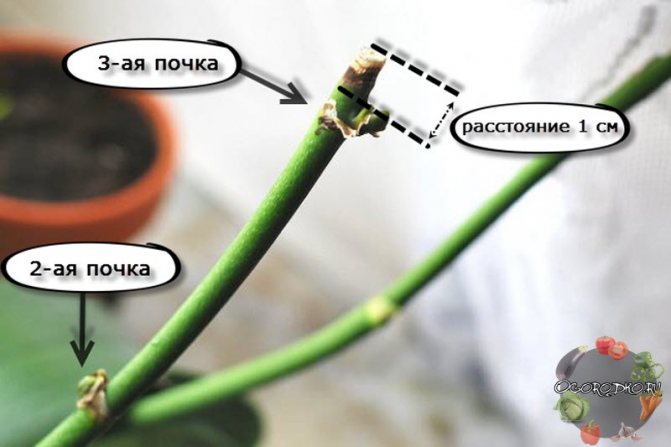

pruning orchid peduncles - pictured
The experience of orchid breeders suggests that it is necessary to trim the peduncle in the region of the third bud, if you cut it closer to the roots - the flowering will be abundant, but belated, and a higher pruning will lead to the growth of the peduncle to the side and your beauty will fall on its side. The ejection of arrows from additional buds occurs faster than from the main bud, so the tropical diva will bloom within a month and a half after the previous flowering.
If you purchased a non-flowering plant and it is in no hurry to please you with buds - take a closer look at the number of shoots, there should be from 5 to 8, if there are fewer shoots - the plant is still too young and flowering can weaken it. The orchid begins to dissolve the buds at 2 - 3 years of age, maybe it makes sense to just wait? Now you know, dear readers, how to make an orchid bloom.
Preventive measures
Since problems with the condition of the plant are easier to prevent than to fix them later, it is useful to remember what you should not do in order to avoid these problems:
- Do not allow waterlogging of the soil and the appearance of water droplets on the foliage, which leads to rotting and the appearance of fungal diseases.
- Orchids should not be watered at night. as this leads to hypothermia and provokes the onset of fungal infections.
- Do not water orchids with tap water, since the salts contained in its composition are deposited on the root processes and prevent them from normally absorbing moisture with nutrients. As a last resort, you can occasionally use well-settled tap water.
- It is not recommended to overuse fertilizers and experiment with their proportions. It is best to use food specially designed for orchids, following the instructions carefully.
- Newly acquired plants should not be immediately placed next to long-growing houses, in order to avoid their infection without an appropriate quarantine period.
- You should not remove the faded peduncle before it dries, because over time (after 2-3 months) the non-dried peduncle can bloom again and even form "babies".
- In no case should you keep the phalaenopsis under the burning rays of the sun, which not only can burn the leaves, but are also able to dry out the aerial roots.
Important! In order for this orchid to appear in all its glory for almost a year, one cannot do without artificial lighting in winter.
Improper care
In other cases, we can talk about violations of the stages of care or an attack by insects, as well as the presence of diseases. To admire the lush and beautiful flowering, the plant owner will need to eliminate errors such as temperature violations, improper watering or top dressing, and adjust the degree of lighting.
Temperature violation
When keeping such a beauty, she needs to provide a temperature close to that available in the natural environment.The orchid will not bloom if the daily temperature drop is less than 5 ° C. For the normal laying of the peduncle, the pot must be transferred to a cool place overnight.
The optimum temperature in summer should be 25-30 ° C, in winter - about 18 ° C above zero.
Moreover, for different types of orchids, temperature indicators will vary. For example, the average daily temperature for the phalaenopsis orchid should be + 18-25 ° C, for dendrobium - from 15 to 25 ° C, cymbidium - from 35 to 38 ° C, pafiopedilum - from 18 to 25 ° C above zero.
Improper watering or feeding
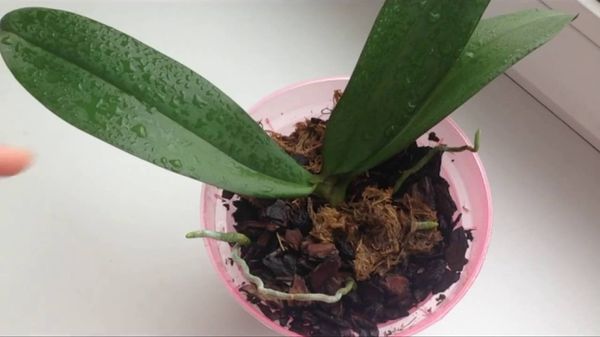

A tropical guest reacts sharply to irrigation and fertilization violations. Since the plant growing in its natural habitat does not bloom during the rainy season due to the lack of pollinators, then with intensive home watering it may not release the shooters. The same will happen if you water the flower with cold water. To ensure abundant and timely flowering, the plant needs to be watered only after the soil dries up. This can be determined by the color of the roots - they should be almost white or at least lightened. To stimulate flowering, some growers combine watering with the introduction of potassium-phosphorus dressings.
There are fertilizers that are needed to build up green mass, as well as those that promote flowering. Preparations with a high nitrogen content are recommended for use during the growing season, that is, in the spring. If at this time potassium-phosphorus fertilizers are applied, which contribute to the formation of buds and a flower arrow, you can provoke untimely formation of flowers and destroy the plant. Also, these dressings are not used during the recovery period of the orchid after damage to the root system.
Lighting problems
If such orchid species as phalaenopsis and papiopedilum can still put up with insufficient lighting, then for other species such a problem can become serious and lead to death. You can determine whether a culture has enough light by the color of the leaves. They should be light green, since the presence of yellow ones is an indicator of excess ultraviolet radiation.
The plant will signal a lack of lighting with bright green leaves. To adjust the amount of light, in the first weeks of the appearance of the orchid, it is necessary to monitor it in order to adjust the amount of light received by the plant.
The problem of lack of flowering is most often solved by moving the pot to a well-lit place or installing artificial lighting. In winter, it is customary to use cold light lamps for supplementary lighting, installed at a distance of no more than 40 cm from the crown of the plant.
Problem prevention
It should be noted that in their natural environment - the tropics - orchids grow on trees, from which their peduncles hang under the weight of buds and flowers. Therefore, the growth of arrows not vertically upwards, but horizontally is a natural process for a given plant, established by nature. The only way to prevent this situation at home is to constantly turn the orchid pot as the peduncle deviates to the side. He will reach for the light, thereby aligning.
As for the problems of "fading" the growth of the peduncle or even the reluctance of the orchid to bloom, there is only one recommendation: strictly observe the requirements for the maintenance and care of an orchid of a certain type.
Orchid care is a laborious process. Difficulties can arise at every turn. Only perseverance, dedication, attentiveness of the grower will help him achieve the main goal when growing an orchid - admiring the beauty of a flower for a long time.
Stimulation methods
There are many effective ways to stimulate orchid re-blooming:
- Temperature drop. The flower must be placed in unusual conditions, that is, at night, rearranged to where the temperature drops to + 7 ... - + 15 degrees (a balcony or loggia is suitable for this).And during the day, the orchid must be placed in a permanent place where the temperature will be at least +20 degrees.
- Change top dressing. It is necessary to remove fertilizers that contain nitrogen and replace them with phosphoric ones.
- Reducing the number of waterings. It implies bringing the flower to a dry state, and then returning to the normal watering regime.
- Place the orchid in the shade for five days.
But you should not blindly trust each method, since all flowers are individual, and for someone the experiments will end in gorgeous flowering, and for someone - the death of the flower. If you intend to keep the orchid healthy, then you need to find out in detail which species is in front of you, how old the flower is, since the orchid can bloom for the first time at the age of 1.5 years. You also need to pay attention to the root system of the flower. Since the roots take part in photosynthesis, they need a sufficient amount of light.
Plant your orchid in clear plastic pots for sufficient light to reach the roots.
Adverse effects of diseases and pests
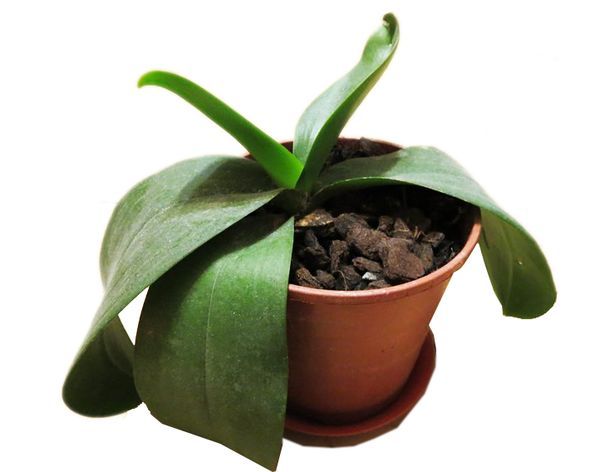

If the flower is affected by viral infections or insects, then it will not bloom. It is necessary to inspect the plant for the detection of pests, bacterial or fungal infections. If a problem is identified, the florist must purchase a drug that will eliminate the nuisance and process the culture. When your pet gains strength, she will start releasing arrows and forming buds. Usually, a flower needs about six months to recover. Root diseases are very dangerous and unpleasant for the plant. The reason may lie in excessive watering, provoking a stagnation in growth, a decrease in leaves in size, as well as the beginning of rotting of the root system. This is due to the fact that water enters the leaf outlet, which then does not dry out normally. Rotting can be prevented by carrying out permanent transplants, which will allow the grower to assess the condition of the roots, and the plant will develop and bloom better in a new substrate.
Extreme ways to stimulate flowering
- Stimulant drugs
... The most common are epin and succinic acid. They must be used according to the instructions. It is believed that after their use, the appearance of peduncles and buds is accelerated. - Bath
... In this case, instead of watering-immersion, the flower pot is placed under the shower in the bathroom. Water it for about 15 minutes with warm water not higher than 35 0 С. Leave in a steamy bathroom until the plant dries and cools. - Creating stressful conditions
... This can be the cessation of watering for a long time (more than three weeks). Or providing a sharp difference (more than 10 0 C) day and night temperatures.
Such events are carried out only with adults (3-4 years old), healthy flowers. If you see that the flower does not like your procedures, then stop them immediately. Better to give them up altogether. If the flower is healthy, and you take proper care of it, then it will choose the time for its flowering itself.
The main reasons for refusing to bloom:
- Root disease
... Most often decay. If the pot is transparent, then it will be immediately noticeable. Healthy roots have a light green light. Rotten - brown or black. - Not enough leaves
... It is possible to stimulate flowering only if there are at least six leaves. With fewer leaves, the plant will not survive stress. - Excess fertilizer
... Especially if there is a lot of nitrogen. In this case, the plant begins to fatten. It releases a lot of leaves, but does not even think to bloom. - Incorrectly organized lighting
... Do not place the flower in the back of the room or in direct sunlight. Organize diffused light. Always turn the pot with the same side towards the light.
Getting multiple stems at home
The number of peduncles on an orchid directly depends on genetic characteristics. of the type that was acquired.An important role is played by such factors as the age of the plant, the power of its root system, the amount and quality of lighting, the regularity of watering, and compliance with the optimal temperature regime.
Provided that all requirements for the care and maintenance of the orchid are met, you can try to increase the number of peduncles as follows:
- After flowering, cut off old peduncles (making sure they are completely dry).
- Treat the leaves and substrate with a fungicide.
- Feed the plant with specialized orchid fertilizers.
After the flower stalk of the orchid dries to the very base, it must be cut off. To do this, you need sharp scissors or pruning shears, activated carbon. With a sharp, clean tool, a dried peduncle is cut off, not reaching two centimeters to the surface of the substrate. The cut site is processed with crushed activated carbon.
Some florists advise: cut the peduncle not completely, but to the uppermost "dormant" bud, since a lateral arrow can begin to develop from it, and the second shoot appears from the leaf axils. Thus, it will be possible to get a plant with two peduncles.
Additional Tips
- Buy a flower in winter. Then the bright spring sun will awaken the sleeping buds. As a result, the flowering period will be lengthened.
- Buy it not with one, but with several peduncles.
- Don't forget to rest the plant. Try to keep at least three to four months between flowering phases.
- Use phytolamps in low light conditions.
- Low temperatures, sharp fluctuations in day and night temperatures, insufficient air humidity, and dried up substrate can be the reasons for the dropping and yellowing of buds on peduncles.
- Do not remove faded peduncles. If they are not completely dry, then cut them to the first dormant bud. This increases the likelihood of more buds appearing.
Temperature.
Sometimes the orchid does not bloom because there is no temperature difference in the room. In natural conditions, even at the equator, there is a difference between day and night temperatures. It hovers around five degrees. Try to achieve flowering by organizing temperature changes in the range of at least two to three degrees. But not with the help of drafts and air conditioners.
Phalaenopsis and shoes release flower stalks when the temperature drops to 13 0 C. When an orchid blooms, it needs a cool temperature (from 16 to 21 degrees). This temperature will increase the flowering time.
Orchid care after flowering
Depending on the type of orchid, after flowering, different methods of care are required. Cattleya's orchid retires after the bulb has faded and matured. She needs to reduce watering by 2-3 times and remove top dressing. Dendrobium King, after flowering, needs a decrease in temperature and very rare watering. General requirements for most orchids are lower temperatures and less watering. The duration of the dormant period is different for each species.
Phalaenopsis, as always, is original. The flowering of the phalaenopsis orchid begins with the fact that the plant grows a long peduncle. Phalaenopsis can grow a peduncle for two months. The length of the peduncle can be up to 1 meter. After a period of flowering, an ugly green stick remains in the middle of the plant. In other hibernating orchids, these peduncles wither, and post-flowering orchid care activities include removing dried parts and replanting. But phalaenopsis practically does not have a rest period, so it is not recommended to cut the peduncle.
Correctly cut peduncle in phalaenopsis
On the other hand, a long bare stick sticking out from the middle of the leaves spoils the whole view. Therefore, orchid growers compromise by cutting the peduncle only partially. The fact is that after flowering, the phalaenopsis orchid almost immediately begins to prepare for the production of new flowers.If the peduncle is cut at the root, then Phalaenopsis will again need about two months to distill a new peduncle.
Creation of lighting and temperature control
If all the comfortable conditions have been created for your favorite flower, thorough care is provided, but you are still looking for a way to make an orchid bloom, then create a little stressful environment for it. To do this, you can change the location of the flower for three / four weeks by placing it in a dark and humid place. As a result of this change in the environment, new kidneys will awaken.
You can also make the orchid bloom by lowering the night temperature. In the summertime, this is easier to do by placing the plant on the balcony, veranda or in the garden. In such conditions, due to the temperature difference between day and night, flowering can begin. In the cold season, this cannot be done, but as an alternative, you can ventilate the room at night (darkness and coolness allows the accumulation of carbon dioxide), thereby stimulating the plant to bloom and form a flower arrow, and not babies. The main thing is to take care of the absence of even the slightest draft.
What are the ways to achieve the appearance of new peduncles in orchids
So, your Phalaenopsis bought in bloom has already bloomed six months ago and it's time for it to bloom again. Before stimulating the plant to bloom, check if your orchid is healthy? Only after a careful examination for the presence or absence of rot and other signs of disease can the methods below be used.
Small young plants under two or three years of age may also not bloom.
Rate the plant, how many young leaves have grown recently? How many roots have appeared, whether they are in active growth or "frozen". Young roots differ from old ones in a delicate green color. If Phalaenopsis has not been growing for a long time, then he simply “fell asleep”.
The reason for the appearance of the orchid peduncle: stress
If the orchid grows beautifully for several months, releases new leaves and roots, but there is no peduncle, it is necessary to create a stressful situation.
- Place the orchid in a bright place with 14-16 hours of daylight.
- In winter, use artificial lighting with lamps to lengthen daylight hours.
- Take care of high humidity with pallets of damp moss or expanded clay.
- Feed the plant with special products, tablets or paste.
For the appearance of arrows, it is most preferable to change the irrigation scheme and create a dry season - water much less often with the substrate completely drying in 2-3 days. This regime must be maintained until the first rudiments of a flower arrow appear. If the air humidity is high, the orchid can have a completely dry season without watering for 3-4 weeks.
In late spring or early autumn, you can take the orchid out onto the balcony to keep it at 20–23 ° C during the day and 10–13 ° C at night. Such a sharp temperature drop stimulates flowering very well. In winter, the temperature difference can be done on the windowsill. However, if the battery is very hot, then it is better to separate the window with foil foam rubber at night so that the warmth of the room does not pass to the window sill, and to remove it in the morning. Still, the natural temperature drop in the open air is preferable.
Video: how to make an orchid bloom again
There are special pills and ointments to stimulate flowering. The most commonly used tablets are succinic acid and cytokinin paste.
For additional stimulation of orchid flowering, fertilizing preparations are used - "Bud", "Ovary", "Blossom".
Succinic acid as a means of stimulating the appearance of a peduncle
Succinic acid strengthens, stimulates and supports plants. After using succinic acid, orchids begin to actively grow roots, leaves, and flower buds awaken.
How to use succinic acid correctly:
- Dilute 1 tablet in 0.5 liters of water (if in bulk - then on the tip of a knife).
- Pour water into a spray bottle and spray on leaves, aerial roots, root collar.
- Water the soil with the rest of the solution or soak the orchid in it for 6-8 hours.
Spraying does not replace top dressing, therefore, after stimulation, the orchid must continue to be fed with complex fertilizers. Succinic acid is best used every three weeks for new shoots to grow.
Using Cytokinin Paste to Re-Bloom
Cytokinin paste is a hormonal preparation based on cytokinin. Thanks to him, dormant buds awaken on the plant, cells begin to actively divide. The paste gives 100% appearance of orchid babies. Cytokinin should be used during the warm season, or provide the orchid with conditions comparable to summer conditions (bright light and warmth).
Application of the miracle paste:
- The paste is smeared with the buds on an already existing peduncle. As a rule, the lowest or highest kidney is chosen.
- Gently remove the top dry scales with tweezers or a knife, under which a small green bud is found. It is necessary to try not to damage both the bud itself and the peduncle.
- The cytokinin paste is squeezed onto the tip of a toothpick and transferred to the kidney. Pea paste - up to 2 mm. For better penetration of the paste, you can slightly scratch the kidney with a sterile needle with gentle and smooth movements.
- Spread the paste over the entire surface of the kidney.
In a week, either a new peduncle or a baby will appear from this bud. Do not overuse stimulation paste. It is enough to process 2-3 buds (on a powerful plant, you can do more), since the orchid will then have to grow this baby or peduncle.
Indications for the use of cytokinin paste:
- deplorable or critical condition of the plant;
- to awaken a flower from a long winter "hibernation";
- uneven plant development.
Do not use cytokinin paste to stimulate flowering in the following cases:
- damage to the orchid by disease or pests;
- the orchid is already blooming profusely and the awakening of extra buds weakens the plant;
- no need to awaken more than three buds with the paste;
- do not smear the roots and leaves of the orchid;
- do not use on young orchids and transplanted babies.
Video: applying cytokinin ointment to an orchid bud
Unsuitable substrate
The quality and structure of the soil also plays an important role in the cultivation of an exotic flower. If the soil was not chosen correctly, the orchid will not bloom. In addition, some varieties do not even grow in poor quality substrate.
Note: If a bad substrate was poured into the pot, the roots of the orchid transplanted into it will begin to rot due to excess moisture. Naturally, in such conditions, there can be no talk of abundant flowering.


Figure 5. For planting orchids, you need to use only a special substrate
The composition of the soil for an exotic flower should include particles of tree bark (preferably pine), peat, some sand and coconut fibers. Ordinary soil is not suitable for flowers, as it absorbs moisture very strongly and contains too many minerals. The substrate, which includes sphagnum moss, also has an increased moisture capacity (Figure 5).
When is the orchid ready to bloom?
Usually, a flowering plant is purchased in the store - this is the only way to determine the type, size and shade of the resulting flower. Since moving an orchid to a new room is always stressful, the first bloom usually does not last long. The peduncle, along with the buds, dries up and falls off, and the plant begins a period of relative dormancy.
The duration of this state depends on the variety acquired. The most frequent guests of this family on our windowsills are Phalaenopsis. They are not very demanding on the conditions of detention, therefore they are ready to bloom already 2-2.5 months after the last flowering.


In the meantime, the plant turns its main forces on the foliage: it forms new leaves and saturates them with green color. It is this saturation that is a kind of signal that the culture is ready to bloom.
Different types of decorative orchids prefer to do this at certain times of the year:
- Phalaenopsis and Pafidopellums usually form flower stalks in winter, from November to March;
- Cymbidiums and Dendrobiums - from October to February, but they also bloom in summer;
- the flowering period of Oncidiums begins in April and usually ends in June;
- Miltonias delight the eye in spring or autumn;
- Cattleya - from spring to the first days of winter.
IMPORTANT! Knowing such a biological calendar, you need to buy different types of orchids precisely during their traditional flowering period. Plants with a disturbed biological cycle are more likely to get sick and grow worse.
The flowering process itself can last from a month to six months. There are cases when buds periodically formed on one peduncle for 8-10 months.
Flowering stimulant - cytokinin paste
You can stimulate orchid flowering with a phytohormonal preparation - cytokinin paste.
Effect of cytokinin paste on peduncles:
- awakens dormant kidneys;
- stimulates growth;
- forms viable shoots;
- accelerates flowering;
- regulates the metabolism of the plant (especially when growth has stopped), preventing aging and dying off.
You need to apply the paste in late winter or early spring.
Procedure:
- Gently remove the scales covering the kidney with tweezers.
- Using a toothpick, apply a small amount of the paste to the kidney and spread the ointment over its surface.
- The result can be expected in 7-10 days, which can manifest itself both in the appearance of a flower, a new peduncle (branching), and in the formation of a new baby.
You can use the paste on no more than three buds of one orchid. During the use of the drug, it is necessary to feed the flower with potassium-phosphorus fertilizers.


Cytokinin Paste is an excellent flowering stimulant
Cytokinin paste should not be used:
- when the plant is sick or affected by pests;
- use on children and young plants;
- apply to roots and leaves.
Do not try to artificially force a young specimen to bloom, which still has few leaves. You can achieve flowering, but the plant itself will weaken - it will hurt and give few buds. Wait until more than 5 leaves grow on the orchid.
Video: how to stimulate orchid flowering
Factors affecting flowering
Sooner or later, the plant fades and does not always begin to bloom again. So why the tropical beauty refuses to bloom:
- The plant has been overfed... In order to sell the orchid faster, farms use fertilizers and stimulants that induce flowering. At home, this is not possible due to the lack of these drugs on the market. But even if they were, their constant use will lead in the future to the death of the flower;


Uncontrolled feeding can lead to the death of the orchid. - Flower maintenance does not match optimal conditions... For each tribe of orchids, there are certain conditions under which the plants develop and bloom well. First of all, this is due to their growing environment in their homeland. Orchids can partially adapt to the conditions of the apartment, but there is a limit to everything;
- The orchid has not reached the flowering age. Recently, traveling abroad, not only to tropical countries, people are tempted by the luxurious flowering of tropical beauties, buy, bring home, sometimes not always legally. If the flowers are in the flask, it is clear that there is no point in waiting for flowering next year. In the event that a plant is quite mature in appearance, this does not mean that it has reached the flowering age. Moreover, he needs to adapt to new conditions;
- The plant is affected by pests or is sick. And this is the saddest thing.Therefore, having brought a new resident to the apartment, it must be treated with insecticide and fungicide without fail;
- The owner doesn't know under what conditions does this type of orchid bloom.
Watering and its features
In most cases, it is recommended to water the plants after the substrate is completely dry. But how can you tell if it's time to water your orchid? This can be determined by the condition of the whitened roots or using a wooden skewer inserted into the pot and left there for several hours. If, after extraction, it is completely dry, then this indicates the need for watering.
Basically, orchids are watered at least two / three times a week. However, regular watering inhibits the formation of flower buds. In natural conditions, bloom is completely absent during the rainy season. If you want to speed up the appearance of the flower stalk, then you can create a semblance of drought without watering the plant for about two weeks. After such a break, you will need to water the orchid abundantly with warm, settled water. Then you can resume the regime, stimulating the appearance of flowering buds.


During the period of growth of the flower arrow, new flowers bloom, so the plant must be provided with the proper level of moisture. After flowering is over, the number of waterings should be reduced to 1 time in 7-12 days. After which the orchid will bloom again.
After the leaves wither, you can trim the peduncle. However, if this is not done or if the cut is made under the very last flower, then "Phalaenopsis" will bloom again. By completely cutting off the arrowhead, the possibility of awakening the remaining kidneys is prevented. The latter, in turn, can form new branches with flowers, not as lush as the first, but no less beautiful. You can turn cut flower stalks into a new orchid by placing them on a substrate or sandy soil, covered with foil to provide warmth, light and moisture to allow them to germinate.

